|
Regimental Colours - Introduction
In Prussia, as well as other European countries, the practice of carrying colours (standards or Guidons), to act as rallying points for troops and to mark the location of units was common. In the general chaos of the battlefield, noise, dust and smoke made it hard to know where one was, and soldiers needed these to be able to determine where they should be. The colours became a symbol of a regiment, and they are always guarded and honored.
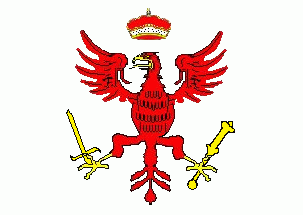
Red Eagle of the
Margraviate of Brandenburg
|
Prussian Military Standards and Colours
The first flags and standards carried by early infantry regiments of Margraviate of Brandenburg (early Brandenburg) usually had a red eagle on them, but soon after Brandenburg became a united kingdom and was known as Prussia, the eagle color was changed to black, although, one of the highest awards a Prussian could receive continued to be the "Order of the Red Eagle."
The Regiments each carried two flags per battalion. The first flag was the Leibfahne or "Colonel´s Colours," and the second flag a Regimentsfahne or "Regiment's colours." The flags all measured 140cm high by 120cm wide. Staff heads were spear shaped and usually had the royal monogram, and in most cases were gold, although some special units had silver ones. Ribbons and tassels were usually silver with black stripes. Prussian flags were painted on cloth, and since the paint soaked through, the design on one side was usually the mirror image of the other. Normally the eagle looked away from the staff. |
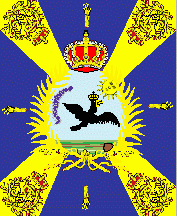
Regimental Colours
(older design)
|
Line Infantry Regimental Colours A musketeer was most common type of infantry soldier and equipped with a musket, hence the name. Musketeers were an important part of early Prussian armies. The relatively short range at which smooth bore muskets could accurately hit a target, added to the slow reload (2 to 3 rounds per minute), meant that massed formation firing was essential for maximizing enemy casualties. The line was considered as the fundamental battle formation as it allowed for the largest deployment of firepower.

Colonel´s Colours
or Leibfahne
|
6th Grenadier Regiment 'Grenadier Garde'
No. 6 Königsregiment
The name grenadier was given to a specialized soldier who threw grenades during assaults. Normally grenadiers were chosen from the strongest and largest soldiers, but Prussian grenadiers were selected for their toughness, reliability and experience rather than size. In times of war, four grenadier companies formed a grenadier battalion of about 700 men. The grenadiers were often used in the most hazardous of tasks and to spearhead assaults.
Normally grenadier companies didn't carry flags, the exceptions were the 6th Regiment Grenadier Garde Bataillon, which was a permanent regiment of grenadiers, and possibly some battalions of the 15th Line Infantry. The 6th Grenadiers was counted as an elite infantry regiment of the line, despite its specialization. By the Seven Years' War, the use of grenades in a field action, as opposed to a siege, was very rare.
Commanders: During the Seven Years´ War, the battalion was commanded by: von Plötz 1756: von Rohr 1758: and von der Busche 1759. |
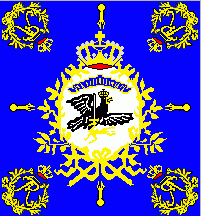
Regimental Colours
or Ordinärfahne
|
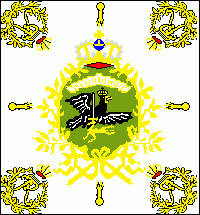
Colonel´s Colours
or Leibfahne
|
10th Infantry Regiment 'Prince Hessen-Kassel'
10 Erbprinz von Hessen-Kassel
This regiment was founded as a single battalion regiment for the Prince of Kurland in 1683. In 1685 it was extended with a second battalion. The prince died in one of the sieges of Budapest and so his brother Prince Ferdinand became the regiment. In 1689 he left the Prussian service, and in 1690 the regiment was split. One battalion became the new number 16, and the other continued under Von Heyden. In 1703 it went into Dutch service. That year the erbprinz of Hessen-Kassel (later king of Sweden) became the regiment. It returned to Prussian service in 1713. In 1715 Frederic of Hessen-Kassel became its colonel.
IR Nr.10: raised 1683, its garrison was in Bielefeld and Herford
Commanders: 1730
Prinz Dietrich von Anhalt-Dessau, 1750 Knobloch, 1757 Pannewitz, 1759
Mosel, 1768 Petersdorff, 1781 Stwolinsky |
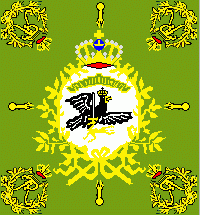
Regimental Colours
or Ordinärfahne
|
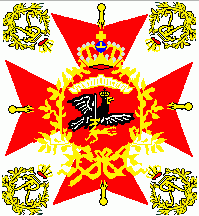
Colonel´s Colours
or Leibfahne
|
19th Infantry Regiment 'Markgraf Carl'
The 19th regiment was established in 1702 by the merging of two companies of already existing regiments - Nos. 4,6,7 and 12 and additional staff from other units.
Lt. General Albrecht Friedrich Marquess of Brandenburg-Schwedt was appointed as its first commander. The commander also had the title of a Lord Master (Herrenmeister) of the Sovereign Military and Hospitaller Order of Saint John. Probably for this reason the Regimental Colour has the same design as the Grand Master's flag of the Sovereign Military Order of Malta, superimposed by the other details of Prussian infantry flags, and the basic colours of the Colonel's Colour just had been inverted.
IR Nr.19: raised 1702, garrisoned in Berlin
Commanders: Markgraf Carl, 1763 Tettenborn, 1763 Herzog, Friedrich von Braunschweig (until 1794)
|
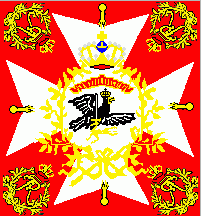
Regimental Colours
or Ordinärfahne
|
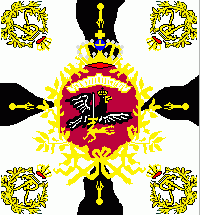
Colonel´s Colours
or Leibfahne
|
21st Infantry Regiment 'von Hülsen'
The typical Prussian infantry regiment of the time was made up of two battalions of six companies each, five of which were musketeers or fusiliers and the sixth were grenadiers. In time of war the two grenadier companies in a regiment would leave their parent organization and join with two from another regiment to form a grenadier battalion of about 700 men. As in all armies the grenadiers were expected to be the best of the infantry, often used in the most hazardous of tasks or to spearhead an assault.
IR Nr.21: raised 1713 from Prussian troops in Dutch service,
garrisoned in Halberstadt and Quedlinburg
Commanders: Marwitz, 1744 Bredow, 1756
Hülsen, 1767 Schwerin, 1773 Erbprinz, 1780 Herzog von Braunschweig |
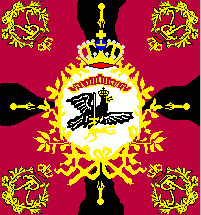
Regimental Colours
or Ordinärfahne
|

Colonel´s Colours
or Leibfahne
|
27th Infantry Regiment 'von Kleist'
The 27th Infantry Regiment regiment was initially composed of German soldiers formerly in the Swedish service and taken prisoner during the Pomeranian campaign. During the War of the Austrian Succession, the regiment took part in the battles of Mollwitz, Chotusitz, and Kesseldorf. During the Seven Years' War, the regiment was one of the first to enter into Saxony in 1756 and faught at the Battle of Lobositz, in 1757 it took part in the invasion of Bohemia and faught at the Battle of Prague, and the Battle of Breslau where it suffered heavily causities, then at the Battle of Leuthen, where its remaining battalion (the First Battalion) was deployed in the vanguard which successfully attacked the Austrian left flank. It was with Fredrick when he contained the Russian invasion of Brandenburg at the Battle of Zorndorf. During the war the grenadiers from the wing grenadier companies were put together with the grenadiers of the Hülsen Infantry forming the Grenadier Batallion 21/27
IR Nr.27: raised 1715 from Prussian troops in Swedish service,
garrisoned in Stendal and Gardelegen (Altmark)
Commanders: Prinz Leopold (von
Anhalt-Dessau), 1747 Jung-Kleist, 1749 Kleist, 1756 Alt-Kleist, 1757
Asseburg, 1759 Lindstedt, 1764 Stojentin, 1776 Knobelsdorff |
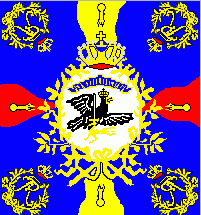
Regimental Colours
or Ordinärfahne
|

Colonel´s Colours
or Leibfahne
|
32th Infantry Regiment 'von Tresckow'
The 32th Infantry Regimentunit was first formed as a fusilier regiment, and during the War of the Austrian Succession it initially garrisoned Fort Preußen on the left bank of the Neiße. In 1745, the unit was transformed into a line musketeer regiment and took part in the Battles of Radun and Ratibor. During the Seven Years' War, the regiment served with the army of Silesia and took part in the Battle of Prague. In 1758, the regiment was part of the army of King Frederick II which invaded Moravia. In 1759, the regiment served in Pomerania against the Russians taking part in the Battle of Paltzig where it suffered heavy losses and was reduced to a single battalion. It went on to served in Saxony, taking part to the victorious action of Korbitz. In 1760, the regiment was garrisoned at the fortress of Schweidnitz where it was captured when the fortress fell.
IR Nr.32: raised 1743 as a fusilier regiment, but renamed as an
infantry regiment in 1745, garrisoned in Minden and Geldern
Commanders:
Jung-Schwerin, 1747 Jung-Tresckow, 1754 Tresckow, 1763 Lestwitz, 1770
Rotkirch, 1786 Hohenlohe-Ingelfingen |
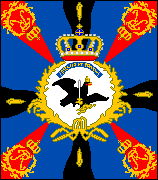
Regimental Colours
or Ordinärfahne
|
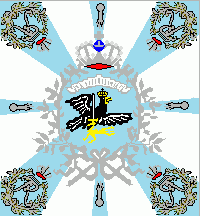
Colonel´s Colours
or Leibfahne
|
34th Infantry Regiment 'Prinz Ferdinand von Preußen'
The regiment was raised on June 28 1740 for Prince Ferdinand, Frederick II's younger brother. During the War of the Austrian Succession, it marched on Moravia, and fought at the battle of Chotusitz. In 1744, the regiment covered Berlin and in 1745 took part to the Battle of Kesselsdorf. During the Seven Years' War, in 1756 the 34th took part in the invasion of Saxony, in 1757 it took part in invasion of Bohemia where it faught at the Battle of Prague, later in the Battles of Breslau and Leuthen. In 1758, the regiment took part in the invasion of Moravia and the unsuccessful siege of Olmütz. On October 14, it fought in the Battle of Hochkirch 1760, and later took part in the Battle of Liegnitz where it suffered heavy losses. In October of 1761, the regiment was transferred to the Pomeranian theatre of operation where it took part to the defence of Schweidnitz.
IR Nr.34: raised 1740 for Frederick II's younger brother from existing Guards regiments and garrisoned in Ruppin
Commanders: Prinz
Ferdinand von Preußen |

Regimental Colours
or Ordinärfahne
|
Fusilier Regimental Colours "Normal" Infantry regiments were known simply as Infantry Regiments (Infanterie-Regiment), but Regiments 33 and 35-49 were Light infantry or Fusilier Regiments (Füsilier-Regiment). Some of these soldiers carried lighter muskets than ordinary infantrymen, while others carried rifles and wore rifle green uniforms. The name fusilier derives from the French word fusil which means flintlock musket. The soldiers of the Prussian Füsilier regiments were equipped as line infantry except for their weapons. They did wear caps and uniforms that were different from those used by the normal Infantry Regiments.
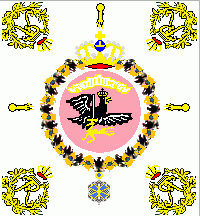
Colonel´s Colours
or Leibfahne
|
40th Infantry Regiment (fusiliers )
The Black Eagle Order (Hoher Orden vom Schwarzen Adler) was established by Friedrich's grandfather King Friedrich I on the day just before his coronation, it was not dedicated to units, but only to Prussian knights. Maybe the chain was added in 1750, when Colonel Johann Friedrich von Kreytzen became commander of the regiment, for he is the only knight of the order and commander of the regiment during the times of King Friedrich the Great.
FR Nr.40: transferred from the service of the Duke of Sachsen-Eisenach
in 1740, garrisoned in Breslau then Schweidnitz
Comanders: Sachsen-Eisenach, 1741 Grävenitz, 1743 Georg Christoph Kreytzen, 1750 Johann Friedrich Kreytzen, 1758 Alt-Kreytzen, 1759 Gablentz, 1777 Erlach (until 1791)
|
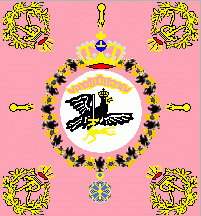 or Ordinärfahne or Ordinärfahne
|
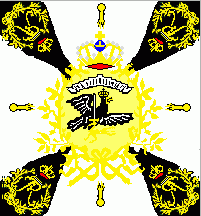
Colonel´s Colours
or Leibfahne
|
46th Infantry Regiment (fusiliers)
Fusiliers were the normal light infantry of the Prussian army. Fusilier was originally the name of a soldier armed with a light flintlock musket called the fusil (French for flintlock). The word was first used in the 1600s, and later came to be a regimental designation.
FR Nr.46: raised 1744, garrisoned in Berlin
Comanders: 1744 Alt-Württemberg, 1757 Bülow, 1776 Lettow, 1779 Pfuhl (until 1791)
|

Regimental Colours
or Ordinärfahne
|
Militia and Garrison Infantry Regimental Colours The Garrison Regiments were not be composed of the fittest men, but they were always expected to serve in combat if the tide of war came their way. The Land Regiments were a different matter - they were the local militia and of little military value. The colours were carried from when the individual regiments were raised.
It should be noted that the grenadiers of garrison regiments were permanently detached from their parent units, and they formed six standing grenadier battalions - stehende Grenadier-Bataillons (SGB) - which served with distinction during the Seven Years’ War. These Grenadier battalions were shock troops, compact and well-led units designated to lead attacks, secure flanks and hold key battlefield positions. Prussian grenadiers carried no flags, allowing them to concentrate fully on the task at hand not worry about losing precious field signs.
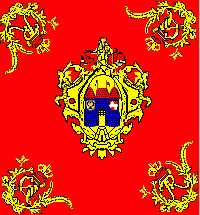
Charlottenburg Militia
|
Charlottenburg Citizen's Militia 1704
Sophia Charlotte of Hanover was wife of Frederick III, regent of Brandenburg-Prussia, thus becoming the Electress of Brandenburg in 1688. After her husband became Frederick I, King in Prussia, she became the first Queen in Prussia in 1701. Their son became King Frederick William I of Prussia, and her brother became King George I of England in 1714.
Charlottenburg was town located to the west of Berlin until 1920, when it became a borough of Greater Berlin (Groß-Berlin). Its militia flag was red with a cypher of Friedrich I in the lower right and upper left corners. In both other corners is the cypher, "SC" for Sophie Charlotte, who gave her name to the city. In the center of the flag is the coat-of-arms of Charlottenburg. |
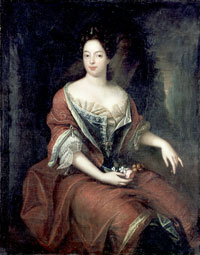
Sophie Charlotte von Hannover
|
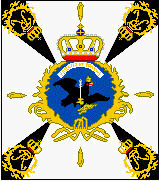
Colonel´s Colours
or Leibfahne
|
Garrison Regiment No. 1 'von Luck'
Frederick the Great raised a number of second-line infantry regiments to garrison towns and fortifications during the Seven Years War. At first they were not trained for field service or granted colours. However, a shortage of front line soldiers eventually made it necessary to activate these garrison regiments into regular combat infantry, and when this happened they were granted their own colours.
Nr. I: The regiment was raised in 1718. Its recruiting area was the towns of Memel, Wehlau, Tapiau, Hohenstein, Nordenburg, Schirwindt and Stallupönen in east Prussia.
Commanders: 1718 Brion, 1728 L'Hopital, 1755 Luck; 1757 Puttkammer, 1766 Alt-Puttkammer, 1771 Hallmann, 1786 Bose.
|
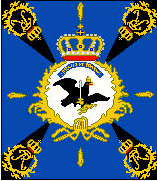
Regimental Colours
or Ordinärfahne
|
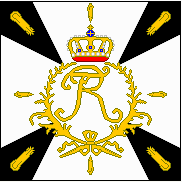
Colonel´s Colours
or Leibfahne
|
Garrison Regiment No. 3 'von Hellermann'
The most senior of the Garrison Regiments date from the reign of Frederick's father - GR1 was raised in 1718, GR2 in 1717 and so on. While they would not be composed of the fittest men, they were on call if needed, similar to the Reserves of today. Garrison Regiments No. 1 and No. 2 had received colors of the normal infantry pattern, but for the rest a new design was introduced, 140 centimeters square with just the royal cypher within the wreath.
Nr. III: The regiment was raised in 1718. Its recruiting area was the towns of Colberg, Bublitz, Usedom and Bütow in Pomerania.
Commanders: 1718 Sack, 1740 Glaubitz, 1740 Hellermann; 1756 Grolmann, 1763 Marschall von Bieberstein, 1767 Heyden, 1772 Vittinghoff. |
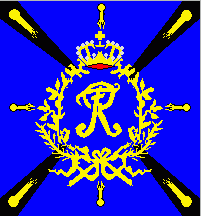
Regimental Colours
or Ordinärfahne
|

Colonel´s Colours
or Leibfahne
|
Garrison Regiment No. 4 'von Grape'
The regiment was raised from men of the regiment Grenadier Garde (No. 6 Königsregiment) as Garnisonbataillon Adam von Wehyer to garrison the star-shaped fort of Magdeburg. It consisted of only one battalion. It had no recruiting canton (area), but was allowed to recruit within the cantons assigned to Regiments No. 3, 5, 20, 21, 27 and 47. Note: The colours for Garrison Regiments 3 and 4 were practically identical.
Nr. IV: Raised in 1740
Commanders: 1740 Wehyer, 1746 Grape; 1759 Jungkenn vom Möhrenstamm, 1760 Lettow, 1763 Plotho, 1766 Großkreutz, 1769 Gohr, 1772 Puttkammer, 1775 Gotter, 1782 Rüchel, 1784 Hüllessem. |
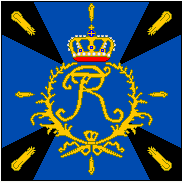
Regimental Colours
or Ordinärfahne
|
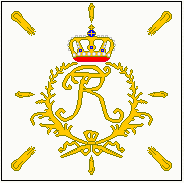
Colonel´s Colours
or Leibfahne
|
Garrison Regiment No. 7 "von Lange"'
Garrison Regiment No. 7 initially only consisted of two battalions formed to do garrison duty in east Prussia, but each included a grenadier company. Until 1754, the regiment garrisoned Neustadt-Eberswalde, Bernau, Templin, Oderberg, Angermünde and then Liebenwalde. In 1754, it left Liebenwalde, but continued to assume garrison duties in the other places until 1756. On August 15 1756, the regiment received 2 additional battalions without grenadier companies. These 2 new battalions garrisoned Müncheberg and Strausberg east of Berlin. At the beginning of 1757, the third and fourth battalions garrisoning Berlin were doubled to form a fifth and a sixth battalion. The regiment lost six of its colours in October of 1757 during the Austrian raid on Berlin.
Nr. VII: The regiment was raised in February 1741 to garrison Stettin (the modern Szczecin in Poland).
Commanders: 1741 Bredow, 1746 Jeetze, 1754 Lange, 1760 Itzenplitz, 1766 Rentzell, 1766 Jung-Puttkammer, 1771 Kowalsky. |
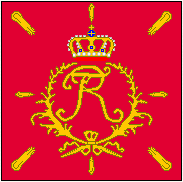
Regimental Colours
or Ordinärfahne
|

Colonel´s Colours
or Leibfahne
|
Garrison Regiment No. 9
"de la Chevallerie de La Motte'
Garrison Regiment No. 9 was raised in Geldern in 1743. It consisted of a single battalion, including 1 grenadier coy, and served as garrison for Geldern until 1756.
The Garrison Regiment No. 9 Leibfahne was the same as that used by Garrison Regiment No. 7, i.e. white with gold devices.
Nr. IX: Raised on August 1, 1743
Commanders: 1741 Kröcher, 1748 La Motte, 1759 Bonin, 1763 Salenmon. |
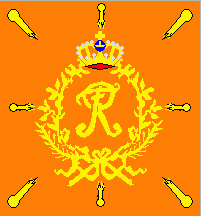
Regimental Colours
or Ordinärfahne
|
Combat Support Units Colours

Pioneer Colours
|
Pioneer Regiment
A pioneer unit is employed to perform engineering tasks, and are also known as sappers. Pioneers' primary job was to assist other Arms in tasks such as construction of field fortifications or military camps. They were also employed during combat to infiltrate and destroy enemy fortifications.
Pontonier's Regiment
An officer or soldier in charge of bridge equipment or the construction of pontoon bridges is known as a Pontonier. A Pontonier regiment would use special pontoon wagons to transport pontoons used to quickly build bridges for river crossings.
|
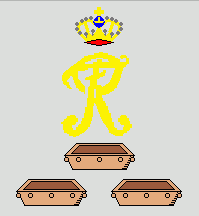
Pontonier Colours
|

Artillery Colours
|
Artillery Regiment (1756)
The artillery was considered one of the weak points in Frederick the Great's army, because he attached his artillery pieces, usually 3 to 6-pounders, among his infantry so each unit had its own cannon. (Kept in reserve were heavier twelve-pounder weapons.) The weakness was this made it difficult to concentrate all artillery fire in one place on large battlefields. His cannons were transported with the infantry on gun carriage with wheels and limbers. The wooden parts were all painted light blue while the metal pieces were painted black.
The artillery was a single battalion in 1740, two battalions in 1741 and three battalions in 1758. In 1762, two regiments, each of three battalions were created; each battalions consisted of five companies. The following year the two regiments became three, of two battalions each. A fourth regiment was added in 1772. There was apparently just one colour for all the artillery, showing a pair of crossed gun barrels superimposed by the mirror emblem on it. |
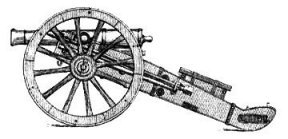
Typical Prussian 3 pound fieldpiece
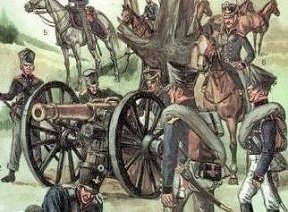
Prussian field battery
|
- My thanks to Klaus-Michael Schneider and Ian Sumner for all their expert help and advice on this page -
|